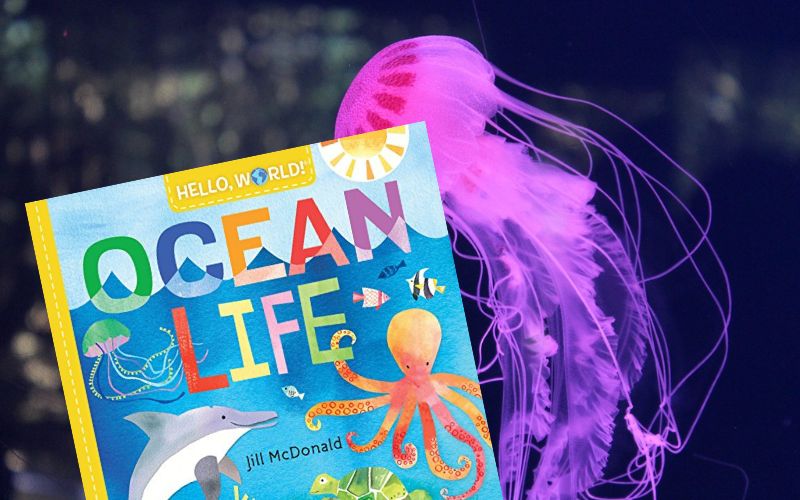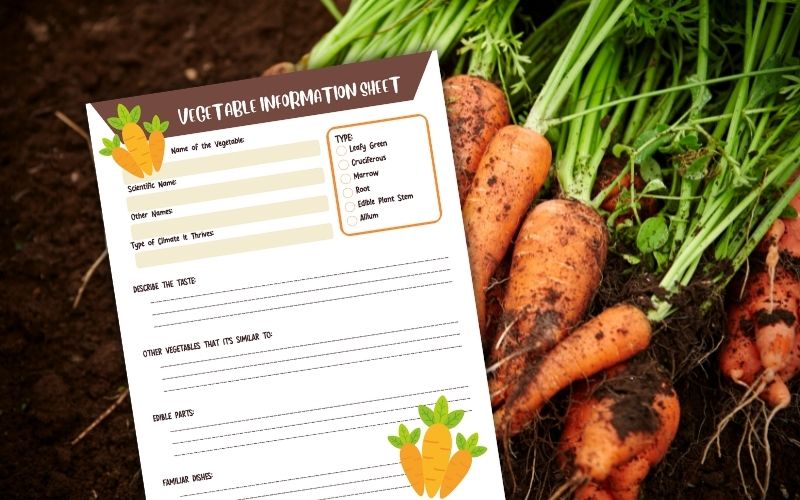Ocean Themed Unit Study Ideas for Homeschoolers
Are you looking to dive into an engaging ocean unit study with your homeschoolers? Look no further! Ocean-themed unit studies offer a fantastic opportunity for your children to immerse themselves in the wonders of marine life while developing key educational skills. With the right resources and creative ideas, you can create an enriching and enjoyable learning experience for your homeschool students.
Be sure to download my free printable unit study planner at the bottom of the post!
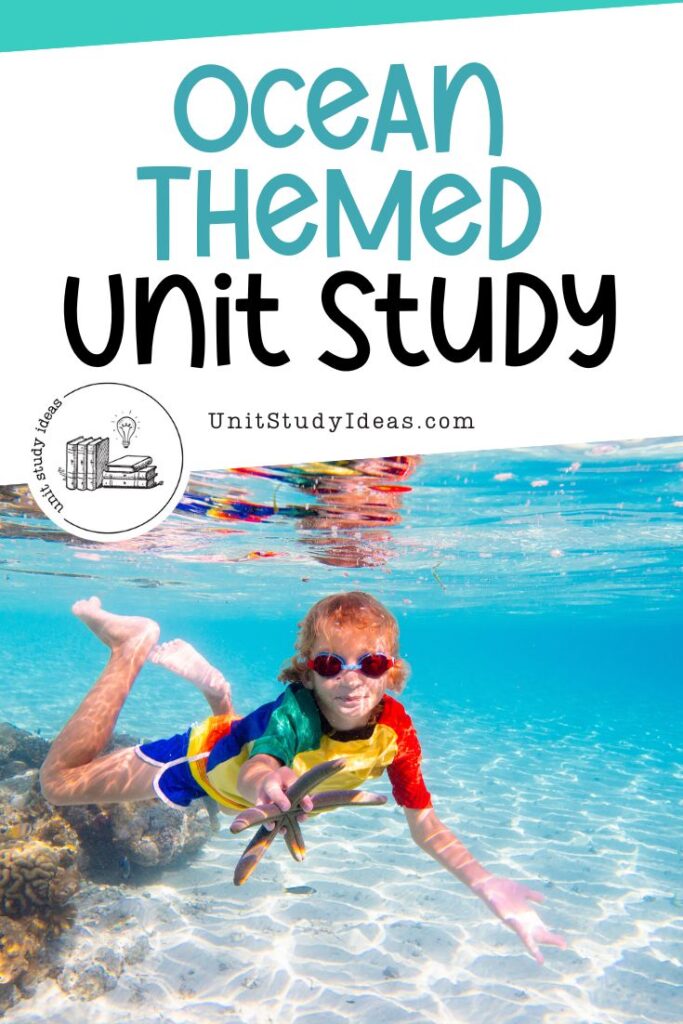
In this unit study, we’ll explore various ocean unit study ideas, hands-on activities, book suggestions, and more for a fun and informative exploration of marine life.
Whether you’re interested in discovering the depths of the ocean, learning about marine animals, or simply creating an exciting underwater world, an ocean-themed unit study is sure to be a valuable and enjoyable addition to your homeschool curriculum.
Getting Started with an Ocean Unit Study
Why Choose an Ocean Theme
An ocean-themed unit study is a fantastic way to engage your homeschooler in the fascinating world of marine life. It allows your child to dive deep into the mysteries of the ocean, exploring various marine species, habitats, and incredible underwater phenomena. The ocean is a vast, unexplored world covering over 70% of Earth, and there’s no limit to the adventures and knowledge your young learner can experience within an ocean unit study. With topics such as marine biology, oceanography, and conservation, your child will develop a profound understanding and appreciation for our blue planet.
Homeschooling Goals and Objectives for Young Learners
When planning an ocean-themed unit study, it’s essential to establish clear goals and objectives for your young homeschooler. Here are some ideas to consider:
- Develop a curiosity and love for marine life: Introduce your child to various ocean species, from invertebrates and crustaceans to mammals and fish. By understanding the diverse life forms found in the ocean, your child will be encouraged to respect and protect these fragile ecosystems.
- Explore ocean habitats and science concepts: By learning about different ocean habitats like mangroves, coral reefs, and tide pools, as well as the ocean zones (sunlight, twilight, midnight, abyss, and trench), your child will gain a deeper understanding of the interconnectedness of Earth’s marine ecosystems. Delve into the scientific aspects like currents, tides, and the impact of the ocean on climate and weather.
- Promote ocean conservation: It’s vital for young learners to be aware of the growing environmental concerns surrounding our oceans and marine life. Engage your child in discussions about pollution, climate change, and resource depletion, and inspire them to take part in eco-friendly practices or conservation efforts.
An ocean unit study offers endless possibilities for you as a homeschooler to provide engaging learning experiences for your child. With a variety of unit study ideas, you can customize your ocean-themed homeschool lessons to suit your child’s interests and needs while fostering a deep appreciation and respect for our planet’s precious marine ecosystems. Happy exploring!
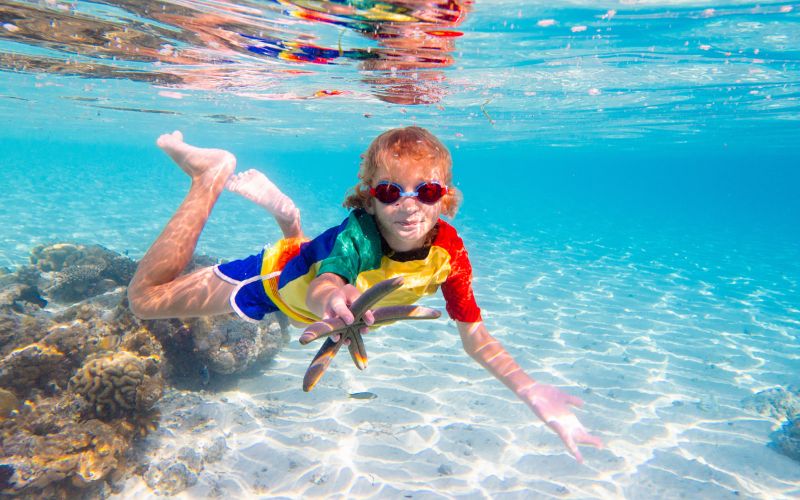
Exploring Ocean Content
Ocean Animals and Marine Life
Dive into the world of ocean animals and marine life with your homeschoolers! Explore various ocean animals like mammals and fish. Introduce your kids to the fascinating lives of sea creatures like sharks and sea turtles. You can even cover the unique aspects of their life cycles and habitats. Create engaging ocean activities, like a sea life-themed arts and crafts session, or study the fascinating sea turtle life cycle.
Studying ocean animals can be a fascinating and engaging topic for homeschoolers. Here are some fun ocean animals that homeschoolers can study:
- Dolphins: Dolphins are intelligent and social creatures. Children can learn about their behavior, communication, and adaptations that allow them to thrive in the ocean.
- Sea turtles: Sea turtles are captivating creatures known for their long migrations. Homeschoolers can explore their life cycle, habitat, and conservation efforts to protect these endangered species.
- Clownfish: Made popular by the movie “Finding Nemo,” clownfish are vibrant and unique creatures. Children can learn about their symbiotic relationship with sea anemones and the special adaptations that help them survive.
- Octopuses: Octopuses are fascinating creatures with complex behaviors and incredible camouflage abilities. Studying octopuses can provide insights into their intelligence, problem-solving skills, and remarkable defense mechanisms.
- Sharks: Sharks capture the imagination of many children. Homeschoolers can delve into different species of sharks, their role in the marine ecosystem, and the importance of conservation.
- Jellyfish: Jellyfish have mesmerizing movements and come in a variety of shapes and sizes. Children can learn about their life cycle, unique adaptations, and the role they play in marine ecosystems.
- Seahorses: Seahorses are enchanting creatures with their distinctive appearance and behavior. Homeschoolers can explore their breeding habits, parental care, and their incredible ability to change color and blend into their surroundings.
- Whales: Whales are the largest animals on Earth, making them a captivating subject of study. Children can learn about different whale species, their migration patterns, communication methods, and the importance of their conservation.
- Coral reefs: Although not animals themselves, coral reefs are vibrant ecosystems teeming with diverse marine life. Homeschoolers can study the different types of corals, their symbiotic relationships with other organisms, and the threats they face due to climate change.
- Penguins: Although primarily found in the southern hemisphere, penguins are beloved by many children. Studying penguins can involve learning about their adaptations for life in extreme cold, their unique social structures, and the challenges they face in a changing environment.
Geography, Oceans, and Seas
Help your students understand the world’s oceans and seas by learning about their geography. Introduce the major oceans and seas, such as the Atlantic, Pacific, Indian, Arctic, and Southern Oceans, as well as the Mediterranean, Red, and Caribbean Seas.
Discuss the role these bodies of water play in shaping our planet’s climate and weather patterns. You can even explore the history of ocean exploration and famous voyages, like those led by Christopher Columbus and Ferdinand Magellan.
Oceanography and Marine Biology
Stimulate your student’s curiosity with topics in oceanography and marine biology. Teach them about the different ocean zones, such as the epipelagic, mesopelagic, bathypelagic, and abyssopelagic zones. Explain how these zones are characterized by factors like water pressure, temperature, and access to sunlight.
Your students can also learn about the role of marine biologists who study the vast and diverse ecosystems present in our oceans.
Emphasize the importance of conserving our oceans and protecting the marine life that calls them home. By covering this engaging content, you’ll inspire your homeschoolers to dive deeper into the world of the sea and its mysterious wonders.
Ocean Facts for Kids
- Pacific Ocean Facts for Kids
- Atlantic Ocean Facts for Kids
- Arctic. Ocean Facts for Kids
- Indian Ocean Facts for Kids
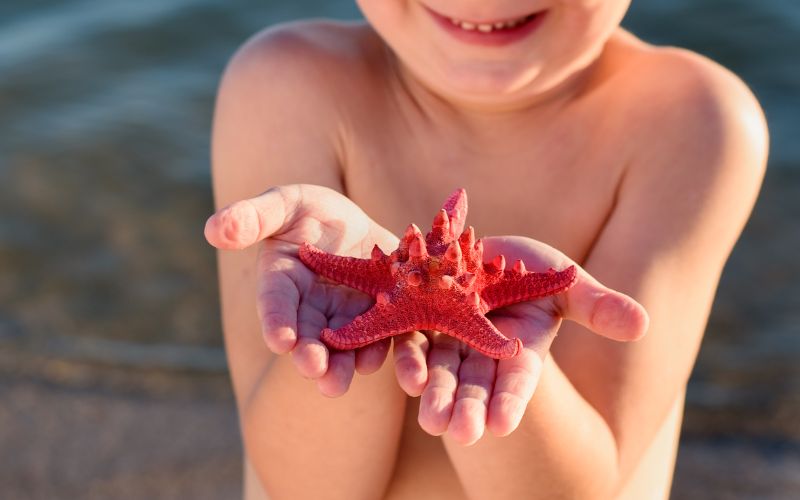
Incorporating Art and Crafts
Underwater Art Projects
Dive into the world of creativity with your homeschoolers by exploring underwater art projects. These activities not only stimulate the imagination but also help kids gain a better understanding of ocean life.
- Watercolor Sea Paintings: Encourage your children to create their own underwater scenes using watercolor paints or colored pencils. This allows them to express their understanding of marine life as they learn throughout the unit study.
- Fish and Sea Creature Collages: Create collages using different materials like magazine clippings, tissue paper, and paint. Kids can cut out shapes of various sea creatures, layering them onto a background to create a dynamic underwater landscape.
Don’t forget to incorporate discussions about ocean life and habitats while working on these art projects, as it reinforces the information they’re learning throughout the ocean-themed unit study.
Beach and Sea Life Crafts
The beach offers endless inspiration for crafts, allowing your homeschoolers to get hands-on with their learning experience. Here are some engaging beach and sea life crafts to include in your ocean-themed unit study:
- Shell Art: Collect sea shells during a beach outing or purchase a bag of assorted shells. Your kids can use these shells to create a variety of crafts, such as mosaics, picture frames, or decorative sculptures.
- Sand Sculptures: If you’re fortunate enough to live near a beach, take advantage of the opportunity to create sand sculptures. This activity helps kids understand the textures and materials found at the beach, while also encouraging collaboration and creativity.
- Paper Plate Jellyfish: Transform ordinary paper plates into lively jellyfish by cutting long tentacles into the plate edges and attaching ribbons or streamers as additional appendages. Add googly eyes and use markers to add personality and color.
By incorporating these art and crafts ideas into your ocean-themed unit study, you will not only cultivate creativity but also spark curiosity about marine life and its various environments. So grab your art supplies and let your homeschoolers dive into a world of ocean-inspired creativity!
Ocean Themed Craft Ideas
- Paper Sting Ray Craft
- Coffee Filter Watercolor Fish Craft
- Suncatcher Jellyfish Kids Craft
- Salt Dough Starfish Kids Craft
Utilizing Books and Printables
Incorporating ocean-themed books and educational printables into your homeschooling curriculum can help introduce your children to various interesting topics related to the ocean. It can improve their reading comprehension and allow them to explore different aspects of ocean life.
Ocean Themed Books
Dive into the world of ocean-themed books by selecting engaging reads for your children. These books come in various formats and cover a wide range of topics from ocean exploration to marine life.
There are both fiction and non-fiction options available for kids of all ages. One example is the 10 Ocean Themed Books for Kids, which can provide a great starting point for developing an ocean-themed book collection. Some other suggestions include picture books, informative guides, and classic ocean adventures so that each child in your homeschool can explore the ocean in a way that resonates with them.
I have a list of 10 more ocean-themed books for young kids here.
Educational Ocean Printables
In addition to books, integrating educational ocean printables in your homeschooling lessons can be an effective and interactive way to encourage your children’s curiosity about ocean life. You can find various ocean-themed printables such as Ocean Lapbook Printables to create personalized lapbooks and worksheets.
These materials cater to different age groups and cover different topics like marine life, habitats, and ocean ecosystems. Along with enhancing reading comprehension, these downloadable resources also provide hands-on activities that can make learning about the ocean an immersive experience.
- Free Ocean Life Marine Biology Printable Pack
- Ocean Animals Study Pack
- Ocean Learning Pack | Sea Life Homeschool Printables
Engaging in Hands-On Activities
Ocean Zones Exploration
This summer, dive into the world of oceanography by exploring the different ocean zones in your homeschool lessons. Start by creating an ocean lapbook to document your adventure in learning about the vast marine ecosystem.
Use hands-on activities, such as crafting dioramas or building models, to help visual learners understand the unique characteristics of each zone. Utilize notebooking pages for writing and drawing their observations.
Remember to cover topics such as the importance of sunlight in the upper layers, the darkness of the deep sea, and the specialized creatures that call each zone their home.
- How to Make an Ocean Diorama
- Clay Sea Turtle Art Activity for Kids
- Ocean Life Notebooking Pages
- Ocean Animals Cursive Copywork
Marine Life Nature Study
There’s no better way to immerse yourself in marine life than by studying the fascinating creatures that live in our oceans. Begin with a super seashore watching unit study that explores the myriad of mollusks and seashells that populate our coastlines. Investigate the various colors, textures, and shapes of these beautiful organisms.
As you progress, expand your nature study to include species such as fish, crustaceans, and even aquatic mammals.
Take advantage of resources like hands-on ocean study for kids, which includes books, games, videos, and hands-on activities to engage and educate your young marine biologists.
Field Trips and Local Aquarium Visits
Plan field trips to nearby beaches or aquatic centers to engage in hands-on ocean activities. Utilize the expertise of local marine biologists to teach your homeschoolers about the importance of ocean exploration and the role that marine ecosystems play in our lives.
Take your ocean unit study to the next level by exploring local aquariums, where your family can get up close and personal with fascinating marine life. Use these visits as opportunities to fill in gaps in their ocean knowledge, explore different continents’ marine environments, and foster a lifelong love for the ocean and its inhabitants.
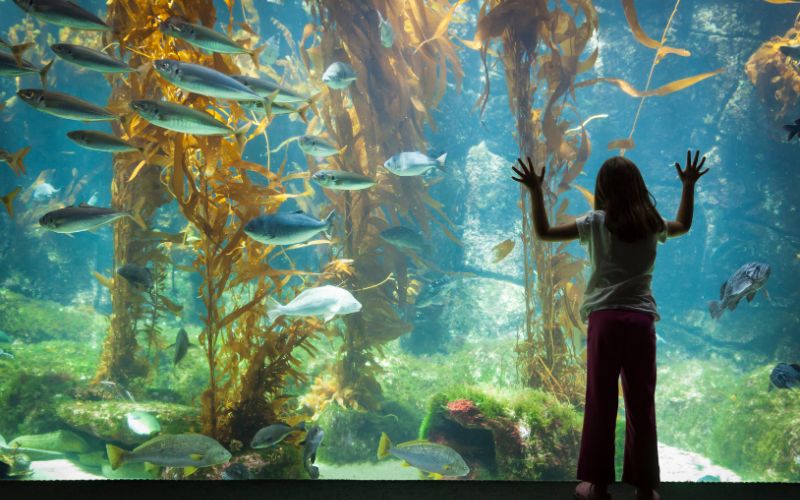
Integrating Other Subjects
Ocean Themed Math Activities
Incorporate ocean-themed math activities into your unit study. Some engaging ideas include counting sea creatures, solving word problems related to sea life, and exploring patterns in ocean waves. You can find various resources that offer ocean-themed math activities tailored to different age groups.
History of Ocean Exploration and Lighthouses
Dive into the fascinating history of ocean exploration by studying famous explorers, such as Christopher Columbus and Vasco da Gama, who navigated the high seas to discover new lands.
Additionally, explore the interesting world of lighthouses, which have played a crucial role in guiding ships and sailors for centuries.
Literature and Reading Comprehension
Enhance your ocean unit study with literature and reading comprehension activities on ocean-related topics.
Choose age-appropriate books and articles that feature sea life, marine habitats, and ocean exploration. Create comprehension questions to encourage critical thinking and in-depth discussions about the material.
Ocean Study Vocabulary Words
Here are some ocean study vocabulary words suitable for elementary students:
- Ocean: A large body of saltwater that covers most of the Earth’s surface.
- Current: The continuous movement of water in a particular direction.
- Tide: The rising and falling of the ocean’s water levels caused by the gravitational pull of the moon and the sun.
- Shoreline: The area where the land meets the ocean.
- Coral Reef: A diverse underwater ecosystem formed by colonies of coral polyps.
- Marine: Relating to the sea or ocean.
- Seashell: The hard protective outer covering of various marine animals, often found washed up on the shore.
- Seaweed: A type of algae that grows in marine environments and is commonly found in coastal areas.
- Estuary: A partially enclosed coastal body of water where freshwater from rivers and streams mixes with saltwater from the ocean.
- Tidal Pool: A small body of seawater trapped in depressions on the shoreline during low tide.
- Mangrove: A type of tree or shrub that grows in coastal saline or brackish water and provides important habitat for many marine species.
- Marine Life: All living organisms that inhabit the ocean, including fish, whales, dolphins, and other marine animals.
- Plankton: Tiny organisms that float in the ocean and serve as the base of the marine food chain.
- Tide Pool: A small pool of seawater left behind on the rocks or sand during low tide, containing various marine plants and animals.
- Seabed: The floor of the ocean, which can include sandy, rocky, or muddy areas.
- Migration: The regular movement of animals from one region or habitat to another, often in search of food, breeding grounds, or better living conditions.
- Ecosystem: A community of organisms that interact with each other and their environment, including both living (plants, animals) and non-living (water, sunlight) components.
- Conservation: The protection, preservation, and sustainable use of natural resources and ecosystems, including efforts to safeguard the ocean and marine life.
- Bioluminescence: The ability of certain organisms to produce light through chemical reactions, often seen in deep-sea creatures like jellyfish or anglerfish.
- Food Chain: The sequence of who eats whom in a particular ecosystem, showing the transfer of energy from one organism to another.
Introduce these vocabulary words gradually and reinforce their understanding through hands-on activities, visual aids, and real-life examples during your ocean study with elementary students.
Ocean-Themed History Ideas
Investigate historical events that have taken place in or near oceans, such as shipwrecks, trade routes, and the impact of oceans on human civilizations. Study the origins of oceanography and how the understanding of oceans has evolved over time.
Classical Music Suggestions for an Ocean Unit Study
Enhance your ocean unit study with classical music inspired by the sea. Composers such as Claude Debussy, Richard Wagner, and Benjamin Britten have created beautiful pieces that evoke the serene beauty and dramatic power of oceans. Listening to these compositions while studying the ocean can provide a rich and immersive learning experience.
Physical Education Ideas for an Ocean Unit Study
Incorporate ocean-themed physical education activities into your unit study to keep your homeschooler engaged and active. Some fun ideas include reenacting a beach day with indoor exercises, playing ocean-themed games, or learning dances inspired by sea life.
Additionally, consider visiting your local swimming pool for some aquatic fun that ties into your ocean unit study.
Expanding Your Ocean Unit Study
As you dive into your ocean-themed unit study, it’s essential to explore various resources and activities to keep your homeschooling journey engaging and exciting. This section will guide you through additional resources, bonus activities, and fun ideas to expand your ocean unit study.
Additional Ocean Themed Resources
There are numerous resources available to supplement your ocean unit study. Here are some suggestions:
- Dive into the Marine Biology Curriculum for an in-depth exploration of the ocean and its inhabitants.
- Enhance your learning with ocean-themed activity books from well-known publishers like DK and Smithsonian.
- Learn about specific ocean animals like turtles, birds, and butterflies using resources like Safari Ltd Toobies.
- Study regional coastal ecosystems, such as rainforests, peninsulas, ponds, and rivers, to understand their connection to the ocean.
Bonus Activities and Fun Ideas
Here are some unique and engaging activities to consider incorporating into your ocean unit study:
- Games: Check out ocean-themed games that will complement your learning.
- Arctic Exploration: Expand your knowledge about the ocean by exploring the Arctic region, studying its unique wildlife, and understanding polar ice caps.
- Dissolve a Seashell: Conduct a fun science experiment by dissolving a seashell in vinegar to learn about ocean acidification and its effects on marine life.
- Field Trip: Visit a local aquarium to observe ocean life up close, take notes, and create a journal of your experience.
- Ocean-Inspired Foods: Integrate ocean-themed foods into your day, such as ice cream, berries, or even jelly in the shape of a jellyfish.
Remember to have fun and explore your creativity when homeschooling. By incorporating a variety of ocean-themed resources and activities, you can create an unforgettable learning experience for everyone involved.
Field Trip Ideas
Incorporating field trips into your homeschool unit study can greatly enhance your child’s learning experience. Here are some fun field trip ideas for an ocean-themed unit study:
- Aquarium: Visit a local aquarium or marine center to observe a wide variety of ocean animals up close. Many aquariums offer interactive exhibits, touch tanks, and educational presentations that provide valuable insights into marine life.
- Beach or Coastal Visit: Take a field trip to a nearby beach or coastal area. Homeschoolers can explore tidal pools, collect seashells, observe shorebirds, and learn about the unique coastal ecosystem. It’s an excellent opportunity for hands-on learning and connecting with nature.
- Whale Watching Tour: If you live in an area where whale watching tours are available, consider taking a trip to observe these majestic creatures in their natural habitat. Local tour operators often provide educational commentary, sharing information about whale behavior, migration patterns, and conservation efforts.
- Marine Research Center: Contact local marine research centers or universities with marine science programs to inquire about guided tours or educational programs. These centers often have research exhibits, laboratories, and experts who can provide insights into ongoing studies and conservation initiatives.
- Boat or Ferry Trip: Take a boat or ferry ride along the coastline or to nearby islands. This allows homeschoolers to observe marine life, seabirds, and possibly encounter dolphins or other sea creatures. Learn about navigation, coastal geography, and the importance of marine transportation.
- Maritime Museum: Visit a maritime museum that showcases the history of seafaring, shipbuilding, and ocean exploration. These museums often feature exhibits on marine ecosystems, nautical artifacts, and interactive displays that provide a comprehensive understanding of our relationship with the ocean.
- Oceanographic Institute: If you’re near an oceanographic institute or marine science research facility, inquire about guided tours or educational programs. These institutions offer valuable insights into oceanography, marine ecosystems, and ongoing scientific research.
- Scuba Diving or Snorkeling Excursion: For older homeschoolers or those interested in marine biology, consider a scuba diving or snorkeling excursion in a suitable location. With proper training and supervision, they can explore coral reefs, interact with marine life, and gain a firsthand understanding of the underwater world.
Depending on where you live, these ideas may or may not work for you. If you do not live near the ocean or an aquarium, you may want to plan for a family road trip or vacation to the beach!
We’ve taken our homeschooled children to a number of aquariums over the years including:
- Ripley’s Aquarium in Gatlinburg, TN
- Tennessee Aquarium in Chattanooga, TN
- Georgia Aquarium in Atlanta, GA
More Ocean Themed Unit Study Ideas
- Discover the Wonders of the Sea: Ocean Themed Books for Kids
- Dive into Creativity: Ocean-Themed Crafts for Kids
- Mangrove Unit Study Ideas for Homeschoolers
Conclusion
Here are a few final suggestions to ensure a successful and enjoyable learning experience for you and your children:
Incorporate multimedia resources like videos, images, and interactive activities to cater to different learning styles and keep your children engaged. Websites such as The Waldock Way and Natural Beach Living offer plenty of ideas and resources to enrich your ocean unit study.
Schedule occasional field trips to local aquariums, marine parks, or even nearby beaches to provide your children with hands-on experiences that can further reinforce their knowledge of the ocean and its fascinating inhabitants.
Finally, remember to be flexible and adapt your plans as needed to accommodate your children’s interests and learning pace. If a particular activity or topic sparks curiosity, don’t hesitate to further explore it and let your children’s enthusiasm guide your ocean unit study journey. Happy homeschooling!
Free Printable Unit Study Planner for Homeschool

How to Download
- Just fill out the form below and you’ll receive an email giving you instant access to this free printable.
- If you are already a subscriber, filling out the form won’t affect your subscription, but you will receive the link to get the printable!
Why should I subscribe?
- access to my subscriber exclusive resource library
- exclusive coupons and sales to my shop
- updates, freebies, and exclusive offers
- instant access to subscriber exclusive printables

